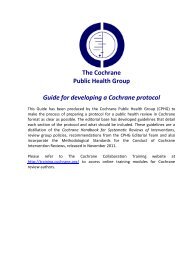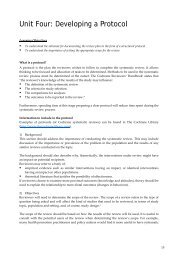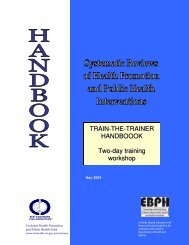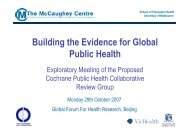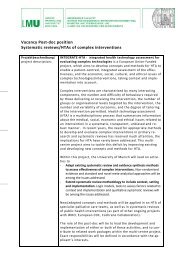Unit Eight: Principles of Critical Appraisal - Cochrane Public Health ...
Unit Eight: Principles of Critical Appraisal - Cochrane Public Health ...
Unit Eight: Principles of Critical Appraisal - Cochrane Public Health ...
Create successful ePaper yourself
Turn your PDF publications into a flip-book with our unique Google optimized e-Paper software.
Example: Families then were randomly assigned to an intervention (n = 65) or control group (n = 70).<br />
An alternate‐day randomisation system was used to simplify intervention procedures and more<br />
importantly to avoid waiting‐room contamination <strong>of</strong> control families by intervention families exiting<br />
the rooms with books and handouts.<br />
Non‐randomised studies <strong>of</strong>ten involve the investigators choosing which individuals or groups are<br />
allocated to intervention and control groups. Therefore, these study designs have high allocation bias<br />
and are likely to produce uneven groups at baseline. Even if every attempt has been made to match<br />
the intervention and control groups it is impossible to match for unknown confounding factors.<br />
Furthermore, there are inherent problems in assessing known confounding factors, as measurement<br />
tools for collecting the information may not be valid.<br />
3) Confounding<br />
Confounding is a situation where there are factors (other than the intervention) present which<br />
influence the outcome under investigation. A confounding factor has to be related to both the<br />
intervention and the outcome. For example, Body Mass Index at baseline would be a confounding<br />
factor when investigating the effect <strong>of</strong> school based nutrition intervention on preventing obesity. A<br />
factor can only confound an association if it differs between the intervention and control groups.<br />
The assessment <strong>of</strong> confounding is the next stage in the critical appraisal process after determining the<br />
method <strong>of</strong> allocation. Remember, randomisation <strong>of</strong> participants or groups to intervention/control<br />
group is the best way to distribute known and unknown confounding factors evenly. Differences<br />
between groups in baseline characteristics that relate to the outcome may distort the effect <strong>of</strong> the<br />
intervention under investigation.<br />
Before beginning to answer this critical appraisal question it is important to determine the potential<br />
confounding factors relating to the particular intervention under question. Good knowledge <strong>of</strong> the<br />
subject area is essential when determining potential confounders.<br />
Example:<br />
Presence <strong>of</strong> confounders: Intervention and control subjects were similar on baseline variables.<br />
Adjustment for confounders: We assessed the effect <strong>of</strong> the intervention after adjusting for sex, age,<br />
baseline BMI and type <strong>of</strong> school.<br />
4) Blinding <strong>of</strong> outcome assessors (detection bias)<br />
Outcome assessors who are blind to the intervention or control status <strong>of</strong> participants should logically<br />
be less biased than outcome assessors who are aware <strong>of</strong> the status <strong>of</strong> the participants.<br />
Detection bias is important in health promotion studies where outcomes are generally subjective. For<br />
example, if outcome assessors were required to interview children regarding their food consumption<br />
in the past 24 hours, they may be more likely to prompt the intervention group to respond<br />
favourably.<br />
Example: Questionnaires were developed based on a review <strong>of</strong> other STD/HIV risk questionnaires<br />
and our findings from focus groups and in‐depth interviews. When administering the 3‐ and 9‐month<br />
follow‐up questionnaires, interviewers were blind to the study group assignment <strong>of</strong> adolescents.<br />
51



